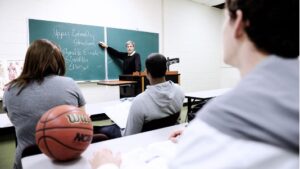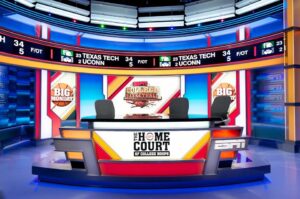By digging deep into the experiences of international student athletes in the United States through the examination of their academic pursuits, athletic endeavors, and future aspirations post-graduation, it’s possible to understand why many international students attempt to come to play their sport. These students face unique challenges and experience great benefits through life-changing events they experience which will follow them long after college life.1

It is evident that student athletes in the U.S. have a high graduation rate. This is because many programs at established universities have a required grade point average threshold required for student athletes to remain eligible to play their respected sports. As competition continues and years go by, the student athletes become well-disciplined to be successful not just on the pitch, court or field, but in the classroom, leading them to be on track for graduation. A study made by Eric Ferris in “Academic Fit of Student-Athletes: An Analysis of NCAA Division I-A Graduation Rates” showed that 57.8% of those that were college athletes had an increased chance of graduation.2

Student athletes have been proven to have an increased drive and motivation to be successful in the classroom due to the pressures coming from their sport to set an example for their peers. Additionally, they stand to make more income post graduation than their peers. According to studies by James E. Long in “The Impact of Participation in Intercollegiate Athletics on Income and Graduation”, the advanced degree variables (MASTERS, PHDPROF) resulted in ATHLETE co-efficients of $701 (t = 2.30) for males and $311 (t =0.91) for females. Study shows the increased efforts these student athletes showed with the participation of their sport.
Further investigation into the lives of foreign student athletes in the United States finds a mosaic of cultural variety and common struggles. These athletes, who are from all over the world, enhance the collegiate environment by bringing not only their physical ability but also their distinct viewpoints and experiences. But in the midst of the thrill of competing abroad, students frequently struggle with the challenges of adjusting to a new school system, negotiating cultural quirks, and getting past language obstacles. Exploring these complex situations highlights the perseverance and resilience shown by international student athletes in their pursuit of academic and athletic excellence.3

Although the high graduation rates of U.S. student athletes provide as evidence to their dedication and perseverance, it is essential to recognize the systemic support structures that contribute to their success. Many established universities offer specialized academic support services tailored to the unique needs of student athletes, ensuring they receive the necessary resources and guidance to thrive academically. From tutoring programs to flexible class schedules, these initiatives empower student athletes to strike a balance between their rigorous training regimens and demanding coursework. International students also take advantage of these resources. 4

Moreover, the symbiotic relationship between athletic participation and academic achievement is evident in the profound impact it has on student athletes’ future prospects. Beyond the confines of the campus, the discipline, time management skills, and leadership qualities honed through sports often serve as invaluable assets in the professional realm. As they embark on their post-graduation journeys, many student athletes leverage their athletic backgrounds to pursue diverse career paths, ranging from sports management to entrepreneurship. There is a transformative power of collegiate athletics, illuminating the myriad opportunities it affords student athletes beyond their collegiate years.5
The first step in gaining a scholarship opportunity in the States is to research and identify colleges or universities that have strong athletic programs in your sport and offer your desired field of study. Considering factors such as academic reputation, athletic facilities, coaching staff, and the level of competition are key to finding one’s desired fit. Once you’ve identified potential schools, reach out to the coaches of those programs to express your interest in joining their team. This can be done through email, phone calls, or attending recruiting events where coaches may be present. Provide coaches with your athletic resume, including details of your sports accomplishments, statistics, awards, and any relevant video footage. Emphasising academic achievements is key as coaches are often looking for well-rounded student athletes to be part of their programs. While not always necessary, some student athletes choose to work with sports agents to help navigate the recruiting process and negotiate scholarship offers for them. If you decide to work with an agent, making sure they are reputable and have experience working with international athletes is key in finding a players desired match. If you’re looking to compete in NCAA sports, you’ll need to ensure you meet the eligibility requirements set forth by the NCAA. This includes academic standards, amateurism rules, and eligibility paperwork. Once you’ve been accepted to a college or university and received a scholarship offer, you’ll need to apply for a student visa. The most common type of visa for international student athletes is the F-1 visa. You’ll need to provide documentation from your school confirming your acceptance and financial support, as well as proof of your intent to return to your home country after your studies. Making sure you are on top of the process has been essential for guys not getting any unexpected delays. The timeline for this entire process can vary depending on numerous factors such as the sport you play, the level of competition, the timing of recruitment cycles, and visa processing times. It’s recommended to start the process well in advance, ideally at least 12-18 months before you plan to enroll in a US college or university.
In conclusion, the journey of international student athletes in the US is marked by resilience, academic success, and transformative experiences. Despite facing cultural adjustments and language barriers, these individuals excel both on the field and in the classroom, showcasing high ability and determination. With high graduation rates and valuable skills acquired through sports, they pave the way for diverse career opportunities post-graduation. Through years of planning and experiences they grow significantly through the power of collegiate athletics.
- Erin Abbey-Pinegar, “The Need for a Global Amateurism Standard: International Student Athlete Issues and Controversies,” Indiana Journal of Global Legal Studies, Vol. 17, No. 2 (Summer 2010 https://www.jstor.org/stable/10.2979/gls.2010.17.2.341 ↵
- Eric Ferris, Mark Finster, David McDonald, “Academic Fit of Student-Athletes: An Analysis of Ncaa Division I-A Graduation Rates,” Research in Higher Education, Vol. 45, No. 6 (Sep., 2004) https://www.jstor.org/stable/40197361 ↵
- James E. Long, Steven B. Caudill, “The Impact of Participation in Intercollegiate Athletics on Income and Graduation,” The Review of Economics and Statistics, Vol. 73, No. 3 (Aug., 1991) https://www.jstor.org/stable/2109580 ↵
- Eric Ferris, Mark Finster, David McDonald, “Academic Fit of Student-Athletes: An Analysis of Ncaa Division I-A Graduation Rates,” Research in Higher Education, Vol. 45, No. 6 (Sep., 2004) https://www.jstor.org/stable/40197361 ↵
- James E. Long, Steven B. Caudill, “The Impact of Participation in Intercollegiate Athletics on Income and Graduation,” The Review of Economics and Statistics, Vol. 73, No. 3 (Aug., 1991) https://www.jstor.org/stable/2109580 ↵


2 comments
Gaitan Martinez
I love how inspiring this article proved to be, and I hope anyone who is aspiring in sports succeeds, but I hope everyone in general succeeds. I won’t lie, I’ve been reading many other posts that have been really depressing like how the US dropped bombs on Hiroshima and Nagasaki, so I’m glad to rinse out the negativity with something very positive.
Lauren Sahadi
This was a great article over student athletes. It showed their resilience and academic achievements, which isn’t usually expected when it comes to the stereotypes of student athletes. A lot of people don’t think about language barriers when students come from different countries, and that was a great highlight of the article. This was an easy, interesting article to read. Great job.